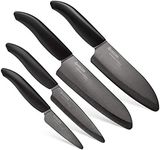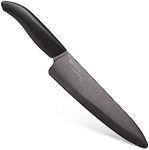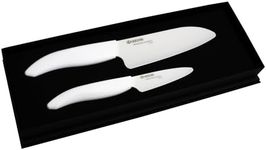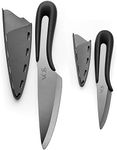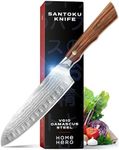Buying Guide for the Best Ceramic Knives
Choosing the right ceramic knife can make a big difference in your kitchen experience. Ceramic knives are known for their sharpness, lightweight feel, and resistance to rust and stains. However, not all ceramic knives are the same, and picking the best one for your needs involves understanding a few key features. By focusing on the main specifications, you can find a knife that matches your cooking habits and preferences, making food preparation easier and more enjoyable.Blade Material QualityThe quality of the ceramic used in the blade is crucial because it affects sharpness, durability, and resistance to chipping. High-quality ceramic is made from zirconium oxide, which is harder and stays sharp longer, while lower-quality ceramics may dull or chip more easily. When comparing knives, look for information about the type of ceramic and its manufacturing process. If you cook often and want a knife that stays sharp with minimal maintenance, opt for higher-grade ceramic. For occasional use, a standard ceramic blade may suffice.
Blade LengthBlade length determines what tasks the knife is best suited for. Shorter blades (around 3-4 inches) are ideal for small fruits, vegetables, and precise tasks, while medium blades (5-6 inches) offer versatility for most kitchen jobs. Longer blades (7 inches or more) are better for slicing larger items but can be harder to control. Think about what you cut most often—if you mostly prepare small produce, a shorter blade is practical. For general use, a medium blade is a good all-rounder.
Handle Design and ComfortThe handle affects how comfortable and safe the knife feels in your hand. Handles come in different shapes, sizes, and materials, such as plastic or rubberized grips. A well-designed handle should feel secure and balanced, reducing hand fatigue during use. If you have smaller or larger hands, pay attention to the handle size and shape. Try to choose a knife with a handle that feels comfortable and provides a good grip, especially if you plan to use it frequently.
Weight and BalanceCeramic knives are generally lighter than metal knives, but there are still differences in weight and balance. A well-balanced knife feels stable and easy to control, making cutting safer and more precise. If a knife is too light, it may feel flimsy; if it's too heavy, it can be tiring to use. Consider how the knife feels when you hold it—if you prefer a lighter touch for delicate slicing, choose a lighter knife. For more control and stability, a slightly heavier, well-balanced knife may be better.
Edge Retention and MaintenanceEdge retention refers to how long the knife stays sharp. Ceramic knives are known for excellent edge retention, but some hold their edge longer than others depending on the ceramic quality and manufacturing. Maintenance is minimal, but ceramic knives can chip if used on hard surfaces or with tough foods. If you want a knife that rarely needs sharpening and you mostly cut soft foods, edge retention is a top priority. If you sometimes cut harder items, look for a knife with a reputation for durability.
Intended UseThink about what you plan to use the knife for. Ceramic knives excel at slicing fruits, vegetables, and boneless meats, but they are not suitable for cutting bones, frozen foods, or hard items. If you need a knife for delicate, precise slicing, a ceramic knife is a great choice. If you need a more versatile knife for tougher tasks, you may want to consider other materials or use ceramic knives alongside other types.
